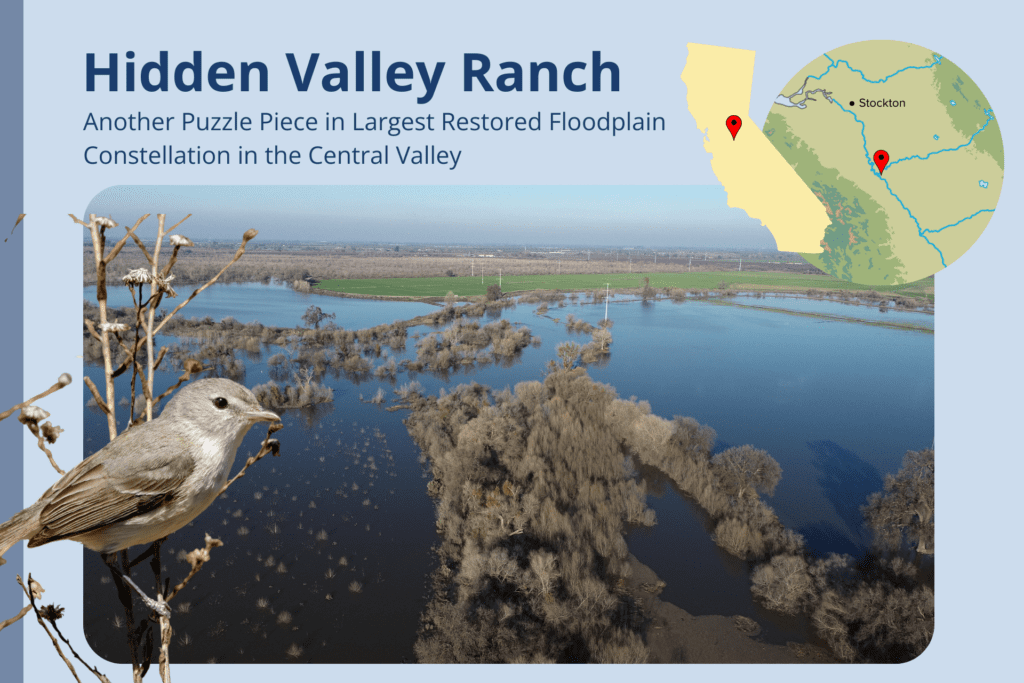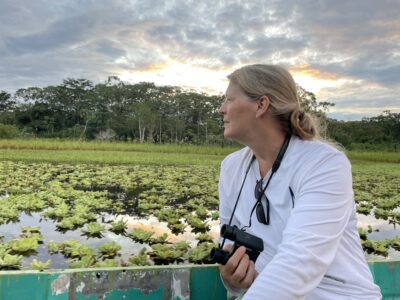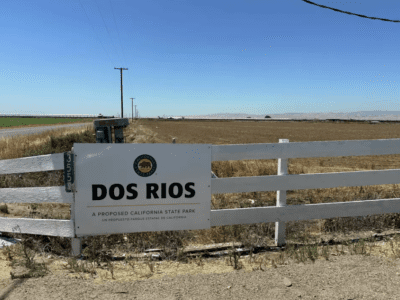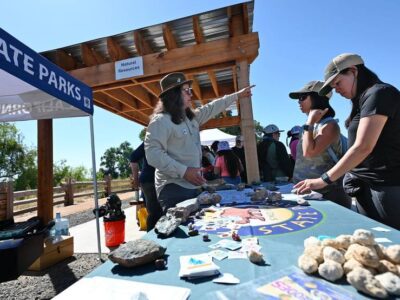The stage is set for a transformative decade that promises to reshape the very contours of California’s rivers and pay big dividends that ripple beyond the water’s edge.
In the face of increasing climate chaos and urgency to save imperiled wildlife like salmon, monarchs, and birds from going extinct, River Partners has been awarded nearly $50 million so far this year in public funding to restore riverways throughout California.
“This is unprecedented,” says River Partners President Julie Rentner. “This is a huge win for flood safety, climate resilience, groundwater recharge, habitat for salmon and other imperiled wildlife, outdoor access for park-starved communities, and so much more.”
From politicians, to farmers, to local communities, Californians are realizing the urgency and importance of rejuvenating our rivers and manifesting a vision of shared prosperity and hope for water, wildlife, and communities. An exceptional alignment of priorities, advocacy, and funding is bringing a remarkable wave of support for river restoration and floodplain reconnection in California.
Since 1998, River Partners has restored more than 18,000 acres throughout California. We blend modern farming practices, cutting-edge science, and diverse alliances to reforest and reconnect entire river landscapes, critical wildlife corridors, and vast ecological regions at a bold pace and scale. In fact, River Partners has the largest on-the-ground restoration footprint of any nonprofit or firm in the western United States.
To ensure a thriving future for people and wildlife, we are doubling our pace of restoration of river landscapes statewide this critical decade. Here’s a preview of the restoration efforts on the horizon that you’ll want to keep an eye on.
8 Restoration Projects To Keep an Eye On
- Rancho Breisgau – Critical Salmon Habitat on Battle Creek
- Upper Butte Basin – Yellow-Billed Cuckoo and Monarch Habitat
- Turning Point Preserve – Giving the Sacramento River Back Its Floodplain
- Dos Rios Norte – Haven for Endangered Wildlife Where Rivers Meet
- San Joaquin Valley – First Tranche of $40 Million in Funding for Floodplains
- Hidden Valley Ranch – Another Puzzle Piece in Largest Restored Floodplain Constellation in the Central Valley
- Great Valley Grasslands – Stronghold for San Joaquin Valley Restoration
- Finney-Ramer – Bringing Life Back to the Salton Basin

Rancho Breisgau
Restoring Critical Salmon Habitat on Battle Creek
Ancestral Territory: Yana, Nomlaki, and Wintu
Breaking ground this fall, River Partners in collaboration with the U.S. Bureau of Land Management is restoring 130 acres of floodplain habitat at near the confluence of Battle Creek and the Sacramento River. Battle Creek is one of the last streams in California that supports all four runs of Chinook salmon as well as steelhead. Restoration efforts will improve fish habitat, reduce habitat fragmentation and support the recovery of critically endangered wildlife species including endangered Swainson’s hawk, western yellow-billed cuckoo, and valley elderberry longhorn beetle. The Rancho Breisgau Unit of the Sacramento River Bend Area is one of the last remaining parcels needed to connect a major wildlife corridor of continuous riparian habitat stretching from the Sacramento River up to the headwaters of Battle Creek in Lassen Volcanic National Park. Project funders and partners include the Wildlife Conservation Board, Western Shasta Resource Conservation District, and CSU Chico.

Upper Butte Basin
Reviving Habitat for Endangered Yellow-Billed Cuckoo and Monarchs
Ancestral Territory: Patwin, Nisenan, and Konkow
Restoration at the Upper Butte Basin Wildlife Area aims to create nesting and stopover bird habitat for a variety of migratory birds and other wildlife, including the endangered western yellow-billed cuckoo and valley elderberry longhorn beetle. River Partners will expand the riparian corridor along Butte Creek by 29 acres and enhance 55 acres of remnant riparian habitat. In addition, restoration will focus on supporting critically threatened pollinator needs by increasing nectar sources for monarch butterflies and other insects.

Turning Point Preserve
Giving a River Back its Floodplain
Ancestral Territory: Patwin
Today, Turning Point Preserve lies within a 30-mile stretch of the most constrained and habitat-poor section of the approximately 385-mile Sacramento River. Levees on both sides of the river from Colusa to Sacramento disconnect the river from its historic floodplains and prevent endangered salmon and other fish from accessing important habitat and food. The approximately 1,000-acre property will be restored in phases starting in December and will transform farmland into native floodplain habitat to benefit endangered salmon and other wildlife. In addition, the restored floodplain will be reconnected with the river to boost flood safety for communities and recharge groundwater aquifers. Project partners and funders include the California Department of Water Resources, the U.S. Bureau of Reclamation, American Rivers, and a variety of other local and regional stakeholders.

Dos Rios Norte
Haven for Endangered Wildlife Where Waters Meet
Ancestral Territory: Patwin and Nisenan
In August, River Partners received $22.6 million from for the acquisition of 1,594-acre Dos Rios Norte, located north of Sacramento at the confluence of the Feather River, Sacramento River, and lower Butte Creek. The property is of critical importance to biodiversity, and River Partners will restore the floodplain, wetland, and riparian habitats to renew a thriving river ecosystem. The restored floodplain will benefit runs of Chinook salmon and improve the safety and reliability of the state’s flood control system in an era of increased severe flooding due to climate change. Following habitat restoration, the water rights associated with the property will be dedicated for streamflow enhancement to benefit fish and wildlife, improving overall ecosystem health. Eventually the restored property will be opened up for public use, including hunting, fishing, birding, and wildlife viewing—boosting public health.
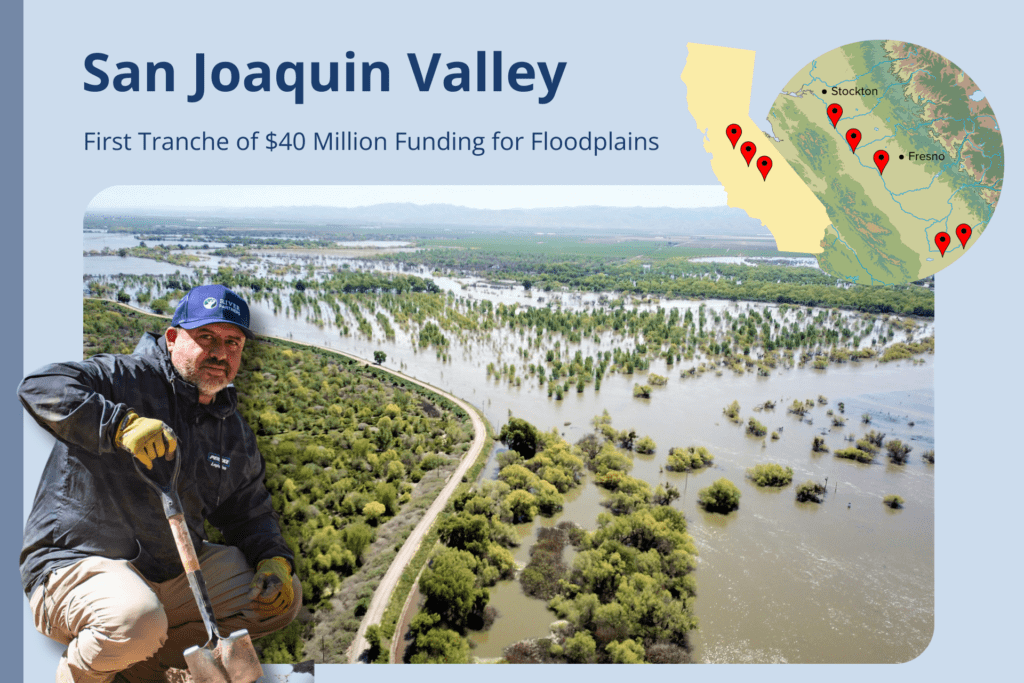
San Joaquin Valley Floodplain Restoration
First Tranche of $40 Million Funding for Floodplains
Ancestral Territory: Yokuts
River Partners received the first tranche of the $40 million allocation from the state budget for floodplain reconnection under AB179 for three projects totaling $21.4 million. Governor Newsom’s revised state budget released in May reinstated the $40 million in critical river-restoration funding to enhance ecosystems and communities throughout the San Joaquin Valley. This downpayment on a brighter future for the valley will support River Partners’ efforts to restore the region’s floodplains to boost flood safety, increase water resiliency, support threatened wildlife, and much more. With catastrophic flooding and prolonged drought predicted to grow in the coming decades, this funding represents an essential investment in building climate resiliency in the valley and beyond.
These projects include:
Research, Planning, and Implementation: Following extensive flooding during this winter and spring, River Partners will restore 330 acres at our historic Dos Rios Ranch Preserve and Grayson Riverbend Preserve, revitalizing native riparian habitats. A further 75-acre restoration at nearby Crows Landing River Ranch includes clearing old dairy structures and planting native riparian habitats. In addition, River Partners and our network of collaborators will identify priority river corridors between Modesto and Bakersfield for floodplain reconnection, readying the pipeline of projects that will improve flood safety and water quality for at-risk San Joaquin Valley communities. Floodplain restoration, planning, and research at multiple sites in the San Joaquin and Tulare basins will help us better understand the connection between floodplains and groundwater recharge, paving the way for 3,000-6,000 acres of future restoration that emphasizes water replenishment for drought security.
Removing Noxious Weeds: River Partners and Madera County will work with local landowners to remove up to 200 acres of invasive Arundo Donax (or giant reed) across multiple tributaries near Cowchilla, El Nido, and Madera in a landscape scale noxious weed removal effort. Removal will boost the local economy of severely disadvantaged communities by providing good-paying green jobs, enhance floodplain habitat, improve water conveyance and flood safety, boost water quality, restore wildlife habitat, and bolster wildfire resilience.
Hidden Valley
Another Puzzle Piece in Largest Restored Floodplain Constellation in the Central Valley
Ancestral Territory: Northern Valley Yokuts
Starting this fall, River Partners is restoring 360 acres of floodplain at Hidden Valley Ranch, a key puzzle piece to restoring the San Joaquin Valley’s largest contiguous corridor of riparian habitat. The ranch is located adjacent to the San Joaquin River as well as River Partner’s historic Dos Rios Ranch Preserve and U.S. Fish and Wildlife’s Grayson Riverbend Preserve and San Joaquin River National Wildlife Refuge which comprise a restored, nearly 11,000-acre riparian corridor west of Modesto in Stanislaus County. River Partners will modify an existing levee to reconnect the river to its floodplain and plant native habitat, providing critical floodplain for struggling salmon as well as improved flood safety for downstream communities. The project will boost water conservation on the property by transitioning former farm fields to low-water native plants and increase groundwater recharge in the area.

Great Valley Grasslands
Stronghold for San Joaquin Valley Restoration
Ancestral Territory: Northern Valley Yokuts
The Grasslands Ecological Area (GEA) of federal, state, and private lands is the largest contiguous habitat mosaic of wetlands remaining in California, displaying a living rainbow of grasses, flowers, and other native plants each year. Located in the otherwise highly engineered agricultural landscape of the San Joaquin Valley, restoration at Great Valley Grasslands State Park within the GEA will reactivate a disconnected floodplain ecosystem to support the recovery of endangered salmon and boost flood safety by removing an obsolete levee and restoring over 200 acres floodplain habitat. Project stakeholders are working to improve public access opportunities for visitors to connect with a rare, relatively undisturbed San Joaquin River ecosystem in California’s most park-starved region. Work is underway, led by American Rivers in partnership with a coalition of local Tribes and project partners, including California State Parks, River Partners, Ducks Unlimited, the U.S. Fish and Wildlife Service, California Department of Water Resources, U.S. Bureau of Reclamation, California Department of Fish and Wildlife, FlowWest, and Central Valley Irrigation District. Local community organizations Cultiva La Salud and Latino Outdoors are local project champions assisting with the development of public access to meet the needs of residents.

Finney-Ramer Habitat Restoration
Bringing Life Back to the Salton Basin
Ancestral Territory: Kumeyaay (Diegueño/Kamia/Ipai/Tipai)
In a region known for one of California’s most dire, ongoing environmental catastrophes, River Partners will restore approximately 1,500 acres along the Alamo River a few miles upstream of its outlet with the Salton Sea in partnership with the California Department of Fish and Wildlife. Over the next three years, River Partners will remove approximately 45 acres of invasive, water guzzling, and highly flammable tamarisk. Then, we’ll plant native forests of cottonwood, willow, and mesquite to help revive struggling wildlife, enhance recreation opportunities, and build climate change resilience. In total, River Partners will restore about 1,500 acres of native habitat along the Alamo River in the next decade. So far, our work in the area helped launch Imperial County’s first native plant nursery.

